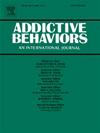Communication attributes modify the anxiety risk associated with problematic social media use: Evidence from a prospective diary method study
IF 3.7
2区 医学
Q1 PSYCHOLOGY, CLINICAL
引用次数: 0
Abstract
Purpose
Social media use in younger people has shown mixed associations with mental health. We hypothesized that communication types during social media use might alter the relationship between problematic social media use (PSMU) and anxiety over time. We aimed to identify how four dimensions of communication influence the link between PSMU and anxiety.
Methods
We recruited a cohort of undergraduate students aged 18–26 to participate in daily surveys over two weeks using a diary method to assess daily social media use, PSMU, anxiety symptoms, and the four dimensions of communication: Consumption, Broadness, Online Exclusivity, and Parasociality. Lagged logistic regression models with generalized estimating equations evaluated the influence of daily PSMU and communication type on subsequent anxiety levels.
Results
Out of 79 participants, 1009 daily records were analyzed. PSMU positively correlated with anxiety (Kendall rank correlation τ = 0.30). Interaction analysis indicated that levels of parasociality and consumption moderated the association between PSMU components and anxiety outcomes. In young adults with high levels of consumption or parasociality, a 1-standard-deviation rise in PSMU’s social conflict component led to an 11 %-13 % increase in next-day anxiety scores. This association was absent for those with low to moderate levels of parasociality and consumption.
Discussion
Elevated levels of passive consumption and one-sided interactions amplify the anxiety risk associated with PSMU. Further longitudinal evidence can elucidate the connections between communication types, social media exposure, and anxiety, guiding the development of a model for healthy social media use.
沟通属性改变了与问题社交媒体使用相关的焦虑风险:来自前瞻性日记方法研究的证据
目的:年轻人使用社交媒体与心理健康之间存在复杂的联系。我们假设社交媒体使用期间的交流类型可能会随着时间的推移改变问题社交媒体使用(PSMU)与焦虑之间的关系。我们旨在确定沟通的四个维度如何影响PSMU与焦虑之间的联系。方法:我们招募了一组年龄在18-26岁的大学生,在两周内使用日记法进行每日调查,以评估日常社交媒体使用情况、PSMU、焦虑症状以及沟通的四个维度:消费、广度、在线排他性和副社会性。使用广义估计方程的滞后logistic回归模型评估了日常PSMU和沟通类型对随后焦虑水平的影响。结果在79名参与者中,分析了1009份日常记录。PSMU与焦虑呈正相关(肯德尔秩相关τ = 0.30)。相互作用分析表明,副社交和消费水平调节了PSMU成分与焦虑结果之间的关联。在消费水平高或社交倾向高的年轻人中,PSMU的社会冲突成分每增加1个标准差,第二天焦虑得分就会增加11% - 13%。这种关联在低到中等程度的副社交和消费人群中则不存在。被动消费和单方面互动水平的升高放大了与PSMU相关的焦虑风险。进一步的纵向证据可以阐明沟通类型、社交媒体曝光和焦虑之间的联系,指导健康社交媒体使用模型的发展。
本文章由计算机程序翻译,如有差异,请以英文原文为准。
求助全文
约1分钟内获得全文
求助全文
来源期刊

Addictive behaviors
医学-药物滥用
CiteScore
8.40
自引率
4.50%
发文量
283
审稿时长
46 days
期刊介绍:
Addictive Behaviors is an international peer-reviewed journal publishing high quality human research on addictive behaviors and disorders since 1975. The journal accepts submissions of full-length papers and short communications on substance-related addictions such as the abuse of alcohol, drugs and nicotine, and behavioral addictions involving gambling and technology. We primarily publish behavioral and psychosocial research but our articles span the fields of psychology, sociology, psychiatry, epidemiology, social policy, medicine, pharmacology and neuroscience. While theoretical orientations are diverse, the emphasis of the journal is primarily empirical. That is, sound experimental design combined with valid, reliable assessment and evaluation procedures are a requisite for acceptance. However, innovative and empirically oriented case studies that might encourage new lines of inquiry are accepted as well. Studies that clearly contribute to current knowledge of etiology, prevention, social policy or treatment are given priority. Scholarly commentaries on topical issues, systematic reviews, and mini reviews are encouraged. We especially welcome multimedia papers that incorporate video or audio components to better display methodology or findings.
Studies can also be submitted to Addictive Behaviors? companion title, the open access journal Addictive Behaviors Reports, which has a particular interest in ''non-traditional'', innovative and empirically-oriented research such as negative/null data papers, replication studies, case reports on novel treatments, and cross-cultural research.
 求助内容:
求助内容: 应助结果提醒方式:
应助结果提醒方式:


